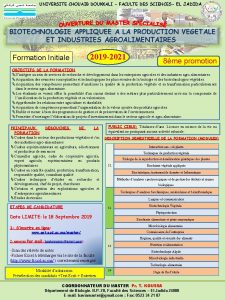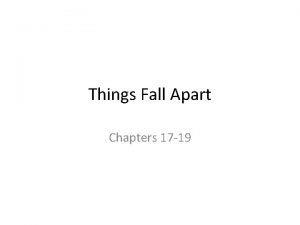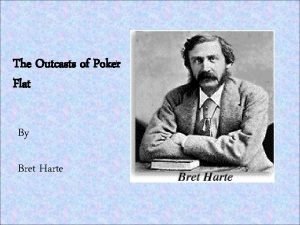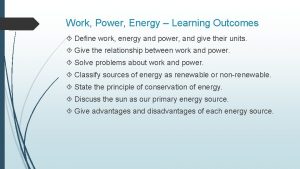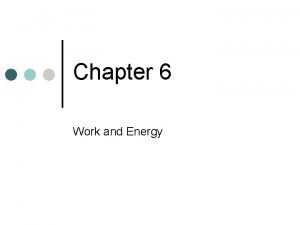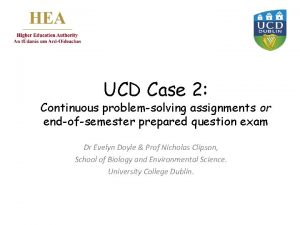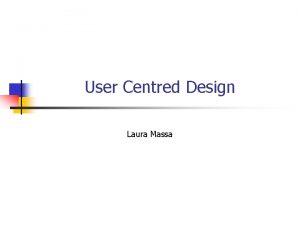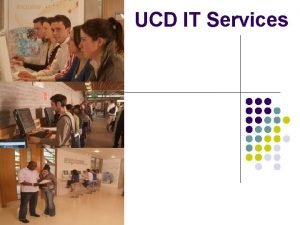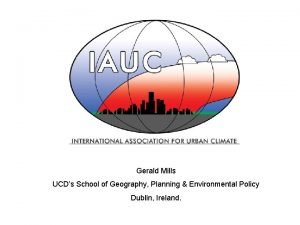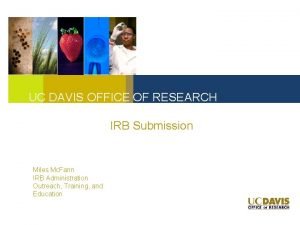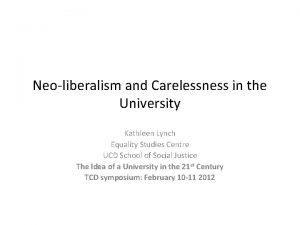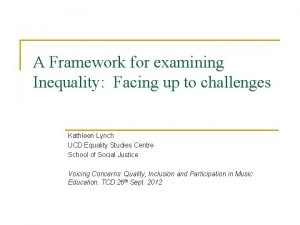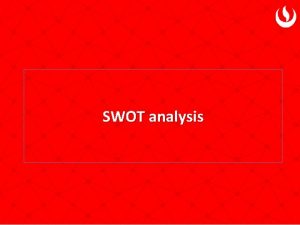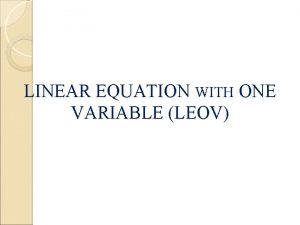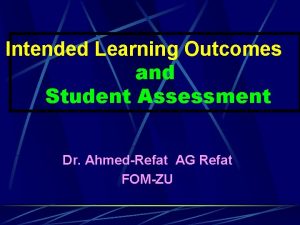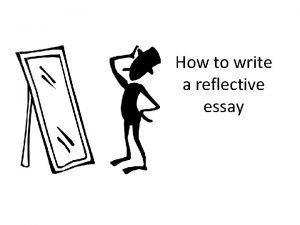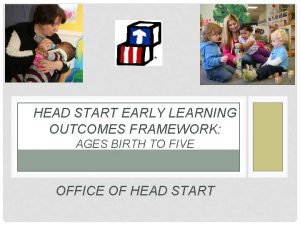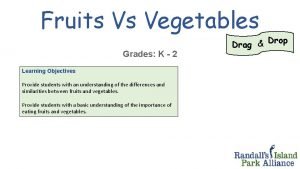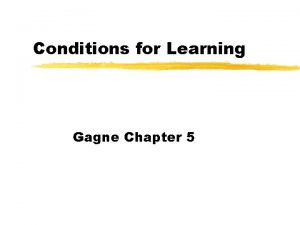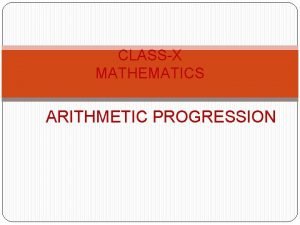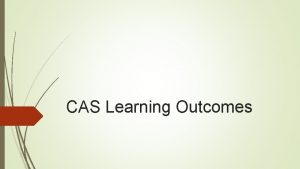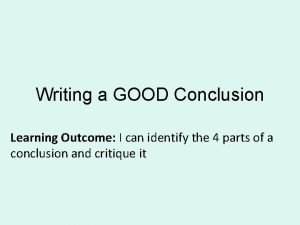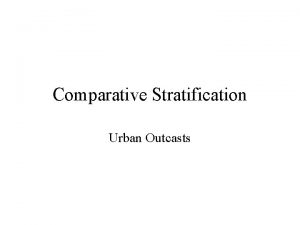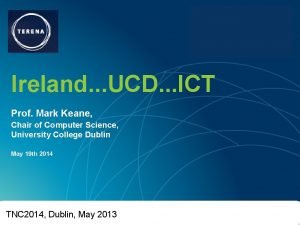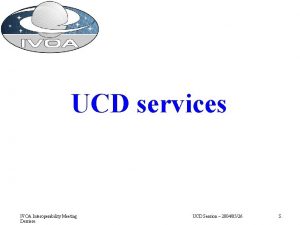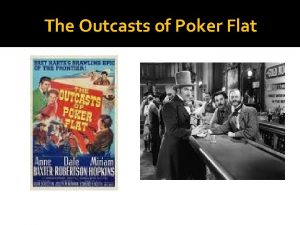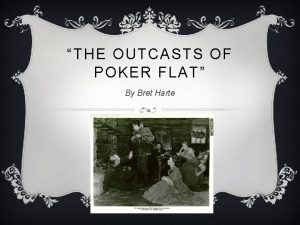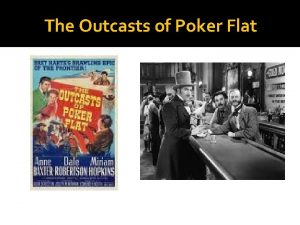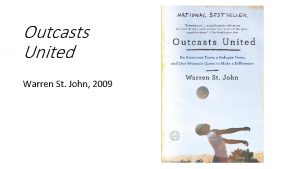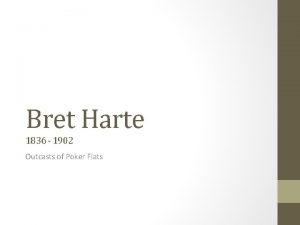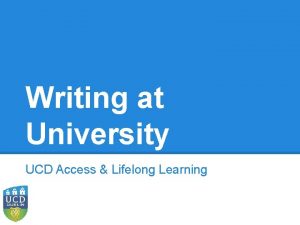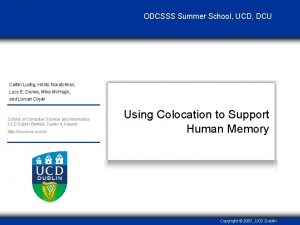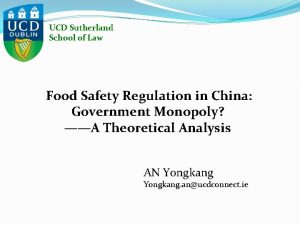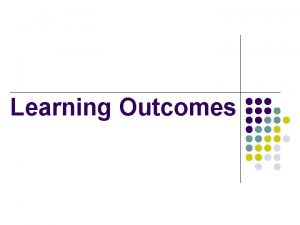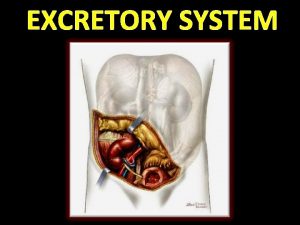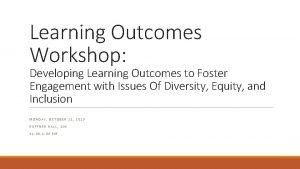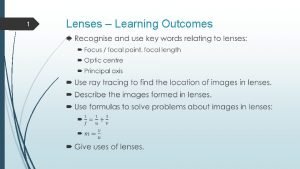Learning Outcomes and Learning Outcasts UCD School of















































- Slides: 47

Learning Outcomes and Learning Outcasts UCD School of Law Presentation by Feargal Murphy 11/10/09


Outcasts • Students not given clear information • Co-ordinators unclear about what they want


Why look at learning outcomes? • Quality Assurance • Bologna Process • Programme planning and time for reflection on modules and programmes • Reviewing content (aims and objectives) • Reviewing connection between level, learning outcomes and assessments

Why look at learning outcomes? • The move to a more learner centred approach

Outcomes and Objectives A Module: Content → Outcomes ↓ Aims/ Objectives Know Distinguish Understand Choose Determine Assemble Appreciate Adjust → Assessment

Are you communicating what you mean?

Some helpful pdfs Guidelines, learning outcomes, strategies available at: www. ucd. ie/tl assessment

Are outcomes clear?


Second level or third level The test of a successful education is not the amount of knowledge that a student takes away after graduation, but the appetite to know and the capacity to learn. If a school sends out students with a desire for knowledge and some idea of how to acquire and use it, it will have done its work. Too many students leave school with the appetite killed and the mind loaded with undigested lumps of Information. (Abbott, 1999)

Types of outcomes • Clear Outcomes What do I have to do to get a better grade? What am I suppose to achieve? • Taxonomies – Bloom’s > Cognitive, Affective, Psychomotor – SOLO – Fink’s Taxonomy

Experts and novices An expert is someone who has made all the mistakes which can be made in a very narrow field. (Niels Bohr, 1885 -1962)


SOLO analysis • Bloom isn’t the only game in town

Learning • Understanding Learning: – Pre-structural – Unistructural – Multistructural – Relational – Extended Abstract

SOLO analysis • Pre-structural • Unistructural

The progress of learning • Multi-structural • Relational • Extended Abstract

Blooming ancient • Bloom’s updated taxonomy - Cognitive – REMEMBERING: define repeat list recall relate – UNDERSTANDING: restate discuss describe explain express summarize – APPLYING: interpret construct apply demonstrate illustrate use – ANALYZING: analyze differentiate compare criticize diagram categorize – EVALUATING: assess judge rate conclude – CREATING: innovate create improve develop

Blooming ancient • Bloom’s updated taxonomy - Cognitive – REMEMBERING: o arrange collect define describe dupicate enumerate examine fund identify label list memorise name order outline present quote recall recognise recollect record recount relate repeat reproduce show state tabulate tell

Blooming ancient • Bloom’s updated taxonomy - Cognitive – UNDERSTANDING: o associate change clarify classify constuct contrast convert decode defend describe differentiate discriminate discuss distinguish estimate explain express extend generalise identify illustrate indicate infer interpret locate paraphrase predict recognise report restate rewrite review select solve translate

Blooming ancient • Bloom’s updated taxonomy - Cognitive – APPLYING: o apply assess calculate change choose complete compute construct demonstrate develop discover dramatise employ examine experiment find illustrate interpret manipulate modify operate organise practice predict prepare produce relate schedule select show sketch solve transfer use

Blooming ancient • Bloom’s updated taxonomy - Cognitive – ANALYZING: o analyze appraise arrange calculate categorise classify compare connect contrast criticise debate deduce determine differentiate discriminate distinguish divide examine experiment identify illustrate infer inspect investigate order outline question relate separate test

Blooming ancient • Bloom’s updated taxonomy - Cognitive – EVALUATING: o appraise argue assess argue choose dompare conclude contrast convince criticise decide defend discriminate explain evaluate interpret judge justify measure predict rate recommend relate resolve revise select support validate value

Blooming ancient • Bloom’s updated taxonomy - Cognitive – CREATING: o Assemble build compose construct create design develop devise formulate write generalise generate hypothesise integrate invent make manage modify organise originate plan prepare propose rearrange reconstruct reflect revise rewrite theorise

Blooming neglected • Bloom’s updated taxonomy – Affective, learning to believing – RECEIVING: ask follow reply – RESPONDING: answer recite perform report select – VALUING: justify propose – ORGANISING: arrange combine compare defend – INTERNALISING: discriminate listen question revise

Blooming handy • Bloom’s updated taxonomy – Psychomotor, observation to mastery – PERCEPTION: detect select listen – GUIDED RESPONSE: copy react follow reproduce – MECHANISM: organise manipulate – COMPLEX RESPONSE: (as above, but complexity mastered, precision and speed improved, uncertainities eliminated) – ADAPTATION: reorganise alter rearrange vary internalise – ORIGINATION: compose construct design initiate create

SOLO together • SOLO Taxonomy • Novice to Expert – PRE-STRUCTURAL: state of student at start of learning – UNI-STRUCTURAL: identify memorize – MULTI-STRUCTURAL: – RELATIONAL: compare/contrast integrate relate apply – EXTENDED ABSTRACT: reflect predict enumerate classify combine theorize generalize hypothesize

SOLO together • SOLO Taxonomy Quantitative: – PRE-STRUCTURAL – UNI-STRUCTURAL – MULTI-STRUCTURAL Qualitative: – RELATIONAL – EXTENDED ABSTRACT

Finking and Linking • Fink’s Taxonomy

Finking pie slices • Fink’s Taxonomy

Samples Outcomes (Level 1!): • 1. Demonstrate a critical understanding of children's literature as a literary genre (demonstrate how? ) • 2. Examine children's literature in the context of traditional forms of literature (outcome or objective) • 3. Assess children's literature in terms of national designations (could be clearer) • 4. Present ideas orally and engage in discussion (how is this assessed? )

More samples Outcomes: • Identify and analyze 'live' aspects in theatrical event; (why both? ) • 2. Define and discuss the role of space and/or the audience in theatrical event; (why both? ) • 3. Identify and investigate theatrical conventions in the context of the performance of texts; (why both? ) • 4. Identify and realise the performance possibilities implied by a particular text; (why both? ) • 5. Develop ideas in writing with respect to the transition of a text from page to stage. (‘express’? )

Samples 3 • 1. Review the range of archaeological methods and approaches. • 2. Demonstrate an understanding of how archaeologists investigate time, space and objects to reconstruct past societies. (how? ) • 3. Visit an archaeological site or museum exhibition and adopt an archaeological perspective to the evidence provided there. (assessed how? )

Digging up outcomes • 1. Review the range of evidence employed by archaeologists to reconstruct the societies of Iron Age Europe and Ireland early medieval Ireland. • 2. Explain how archaeologists use this evidence to understand specific aspects of the Iron Age and Medieval worlds such as technology, social organization, religious beliefs and artistic achievements. • 3. Identify & define important points in the history of Europe and Ireland, 750 BC to 950 AD

Just keep digging • Critically assess various approaches, debates and current issues in environmental archaeology studies of context, and relate these to other contextual approaches • Critically appraise the relationships between disciplines and schools of thought involved in the interpretation of ancient sites, landscapes and environments • Carry out a detailed case study in specific on-site approaches, and develop high-level research designs for assessing and conducting environmental archaeological studies on site. • Compare and contrast different approaches to landscape (e. g. culture-historical, processual, postprocessual) • Communicate effectively (both written and oral expression) about interpretative approaches in landscape archaeology - Apply learning skills to other coursework in the programme

Outcomes feed assessment Assessment – Less; More often – Continuous assessment … continuous?


Assessment feeds learning Why Assess? • Help students learn • Guide student’s improvement • Get feedback on teaching methods • Prompt students to engage with learning • Classify or grade students for external bodies • Get students to do some independent learning • ? guarantee quality • ? because we always do • ? place students in a relative order • ? let parents how their offspring are doing

Assessment • What is assessed? • Not the student ………… their produced work, although students feel like they are being assessed • We must help students produce their best work

Are we clear in assessments?

Educators and the learner

The Menu…. . Assessment • Exams • Vivas / Oral exams • Essays • Reviews and Annotated Bibliographies • Reports • Projects • Portfolios • Presentations • MCQs

Assessment types Formative assessment ‘… often means no more than that the assessment is carried out frequently and is planned at the same time as teaching. ’ (Black and Wiliam, 1999) ‘… provides feedback which leads to students recognising the (learning) gap and closing it … it is forward looking …’ (Harlen, 1998) ‘ … includes both feedback and selfmonitoring. ’ (Sadler, 1989) ‘… is used essentially to feed back into the teaching and learning process. ’ (Tunstall and Gipps, 1996) Summative assessment ‘…assessment (that) has increasingly been used to sum up learning…’(Black and Wiliam, 1999) ‘… looks at past achievements … adds procedures or tests to existing work. . . involves only marking and feedback grades to student … is separated from teaching … is carried out at intervals when achievement has to be summarised and reported. ’ (Harlen, 1998)

Questions and Comments

 Faculté des sciences el jadida
Faculté des sciences el jadida Things fall apart 17-19
Things fall apart 17-19 The outcasts of poker flat foreshadowing
The outcasts of poker flat foreshadowing Outcasts united summary
Outcasts united summary Example of learning objectives
Example of learning objectives Learning outcomes of direct and indirect speech
Learning outcomes of direct and indirect speech Modern input devices
Modern input devices Learning outcomes of work and energy
Learning outcomes of work and energy Sales and revenue are the same
Sales and revenue are the same Learning outcomes of work and energy
Learning outcomes of work and energy Indian and international number system
Indian and international number system Ucd library catalogue
Ucd library catalogue Evelyn doyle ucd
Evelyn doyle ucd Fannie mae ucd
Fannie mae ucd Massa ucd
Massa ucd Ucd it support
Ucd it support Ucd organisational chart
Ucd organisational chart Gerald mills ucd
Gerald mills ucd Ucd engineering erasmus
Ucd engineering erasmus Uc davis irb forms
Uc davis irb forms Ucd trello
Ucd trello Kathleen lynch ucd
Kathleen lynch ucd Kathleen lynch ucd
Kathleen lynch ucd In the afylin framework learning outcomes are arranged
In the afylin framework learning outcomes are arranged Water cycle learning outcomes
Water cycle learning outcomes Notice writing learning objectives
Notice writing learning objectives Objective of swot analysis
Objective of swot analysis Understand rhymes
Understand rhymes Photosynthesis chlorophyll
Photosynthesis chlorophyll Learning outcomes of nutrition in plants
Learning outcomes of nutrition in plants Ncbts
Ncbts Learning outcomes of linear equations in one variable
Learning outcomes of linear equations in one variable Learning outcomes generator
Learning outcomes generator Purpose of learning outcomes
Purpose of learning outcomes Biological level of analysis
Biological level of analysis How to write an introduction for a reflective essay
How to write an introduction for a reflective essay Learning outcomes of holy week
Learning outcomes of holy week What is easter
What is easter Headstart early learning outcomes framework
Headstart early learning outcomes framework Learning objectives of fruits
Learning objectives of fruits Gagne learning outcomes
Gagne learning outcomes Conclusion for arithmetic progression
Conclusion for arithmetic progression Lesson plan of a gift of chappals
Lesson plan of a gift of chappals Cooking learning outcomes
Cooking learning outcomes Ppst domain number strand
Ppst domain number strand Humalog sliding scale chart
Humalog sliding scale chart Cas learning outcomes
Cas learning outcomes Conclusion of learning outcomes
Conclusion of learning outcomes
